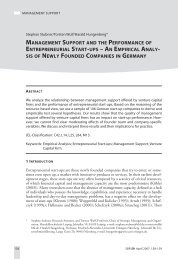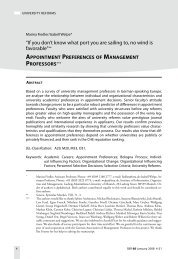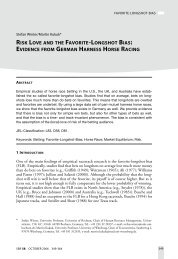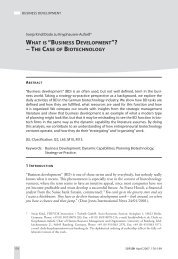components and parameters of corporate reputation - sbr ...
components and parameters of corporate reputation - sbr ...
components and parameters of corporate reputation - sbr ...
Create successful ePaper yourself
Turn your PDF publications into a flip-book with our unique Google optimized e-Paper software.
Corporate Reputation<br />
The RQ-Index is the most advanced measurement model with respect to the<br />
remarks in section 2.1. Moreover, we may appreciate that not experts, but a broad<br />
range <strong>of</strong> stakeholders, is surveyed. A thorough discussion on validity <strong>and</strong> reliability<br />
<strong>of</strong> all described rankings cannot be given in this paper since operationalizations<br />
are not given (Fortune, Fombrun) or not existent (ManagerMagazin).<br />
4 AN EMPIRICAL ANALYSIS OF CORPORATE REPUTATION<br />
4.1 METHODOLOGY<br />
Our research design is a multi-stage design <strong>and</strong> essentially follows the C-OAR-SE<br />
procedure suggested by Rossiter 63. We define <strong>corporate</strong> <strong>reputation</strong> as given in section<br />
2.1, <strong>and</strong> determine that the raters must be the different stakeholder groups.<br />
After screening <strong>and</strong> evaluating the relevant literature on <strong>corporate</strong> <strong>reputation</strong>, we<br />
conducted a qualitative study to uncover if <strong>and</strong> what aspects were not considered<br />
(or at least not appropriately) in existing measurement tools. The resulting aspects<br />
are given in the following section. They are first- or second-order formed attributes<br />
64, i.e., categories that are built by formative indicators. Unlike reflective or<br />
effect indicators, which are supposed to be caused by the underlying latent variable<br />
65, formative indicators are variables that cause a latent variable or construct.<br />
Therefore, correlations between indicators are destructive rather than helpful.<br />
In our first stage analysis, we operationalized most <strong>of</strong> the constructs using several<br />
similar (or only slightly different) items. This procedure was necessary because<br />
most publications on <strong>corporate</strong> <strong>reputation</strong> do not give any details on the questionnaire<br />
used to measure <strong>corporate</strong> <strong>reputation</strong>.<br />
A set <strong>of</strong> 37 items was then pruned during a small quantitative study (332 prob<strong>and</strong>s)<br />
using a convenience sample. The resulting set still contained 21 explanatory<br />
items which were finally tested in a large, multinational r<strong>and</strong>om CATI study.<br />
From these data we received incitements to index construction by looking at the<br />
correlations between indicators first, using exploratory factor analysis. Index construction<br />
then was done using MIMIC models 66. For our conceptualization based<br />
on attitude theory, two endogenous constructs were necessary. Referring to the literature<br />
on br<strong>and</strong> equity, we could derive useful hints concerning the operationalization<br />
<strong>of</strong> the affective endogenous construct, as shown in section 4.6. Due to a<br />
lack <strong>of</strong> literature on this issue, the cognitive endogenous construct had to be operationalized<br />
based on expert knowledge. Using a multiple linear regression analysis,<br />
we finally determined the impact <strong>of</strong> our indices on both our latent endogenous<br />
constructs.<br />
63 See Rossiter (2002), pp. 306 – 308.<br />
64 See Rossiter (2002), p. 314.<br />
65 See Diamantopoulos/Winklh<strong>of</strong>er (2001), p. 269, <strong>and</strong> references given there.<br />
66 See Diamantopoulos/Winklh<strong>of</strong>er (2001), p. 272. MIMIC models are the suitable technology to estimate<br />
path coefficients when formative indicators are used to describe a latent variable. Path coefficients<br />
may then be used as weights to calculate an index.<br />
<strong>sbr</strong> 56 (1/2004) 57






